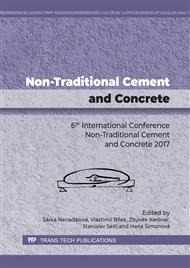p.159
p.163
p.169
p.175
p.181
p.189
p.193
p.197
p.204
Solidia Cement an Example of Carbon Capture and Utilization
Abstract:
Solidia Cement is a non-hydraulic binder that is produced in existing cement kilns using the same raw material as Portland cement (PC). The key difference is that the Solidia binder is produced using less limestone and at lower kiln burning temperatures. This translates into reduced CO2 emissions during cement manufacturing (30% reduction). The Solidia concrete solution consists in a mix between the binder, aggregates, sand, water that is reacted with CO2 to form a durable matrix. The curing process captures up to 300 kg of CO2 per ton of cement used. Together, the Solidia cement and concrete reduce the CO2 footprint by down to 70% when compared to conventional cement and concrete products.The advantages to precasters are multiple also:- Full strength in concrete parts achieved within 24 hours thus allowing just-in-time manufacturing and a significant reduction in inventory cost.- Concrete waste from forming process is almost eliminated and equipment cleanup time is significantly reduced because the concrete does not harden until it is exposed to CO2.- The final precast products present better aesthetics than PC-based concretes (no efflorescence, better pigmentation, and better color grading).The first industrial demonstrations (cement production and precast applications) were achieved and confirm the CO2 and energy savings announced.
Info:
Periodical:
Pages:
197-203
Citation:
Online since:
January 2018
Authors:
Keywords:
Price:
Сopyright:
© 2018 Trans Tech Publications Ltd. All Rights Reserved
Share:
Citation:


